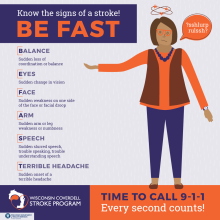Chronic Disease Prevention Program
Helping Wisconsin residents live their best lives

We want everyone in Wisconsin to live their best lives.
However, many people have chronic illness. Health inequities also threaten our vision for people living their best lives. Why? Chronic diseases are common and costly. They can be deadly, especially without the right treatment.
Studies have shown that effective prevention can completely avoid or delay many chronic diseases.
Also, people who already have these conditions can benefit from improved access to care, help managing their symptoms, and more.
That’s why the Chronic Disease Prevention Program (CDPP) is an integral part of Wisconsin Department of Health Services (DHS).
Our program is housed in the Division of Public Health and the Bureau of Community Health Promotion (BCHP).
We’re funded and supported by DHS and through cooperative agreements from the CDC (Centers for Disease Control and Prevention) and other organizations.
CDPP announces regional roundtable
Building on the energy and insights from conversations last fall, this one-hour virtual session on Tuesday, March 3, 2026, brings partners together across regions and programs to continue strengthening collaboration in public health and chronic disease prevention.
Register for the March 3 roundtable today!
Monthly partner calls highlight important topics
The CDPP holds monthly webinars for our public health and community partners.
These meetings, from January to October, led by a variety of subject matter experts cover a broad range of chronic disease prevention topics.
January 27, 2026, at 9 a.m.
Improving Blood Pressure Control with Target BP
Presenters from the American Heart Association share details about the Target BP program, self-measured blood pressure education efforts, and preview the American Heart Association Heart Month promotional materials.
Please subscribe for a monthly reminder email and topic preview.
The CDPP Partner Call Archive contains previous CDPP Partner Call webinars for review.
What we do, and why we do it
We want to face your health issues head on. We work hard to address environments, systems, and health behaviors linked to key chronic diseases and precursors. Our program’s impact spans all ages and across multiple settings. These include:
- Health care.
- Local communities.
- Early care and education.
- Schools.
- Work sites.
All aspects of a person’s health are connected. That means having one chronic disease often means you’ll develop other conditions. Preventing or properly treating patients with conditions such as type 2 diabetes can improve brain health. It also can lower their risk of other conditions, such as Alzheimer’s disease.
Social Determinants of Health have a strong influence on chronic disease. These factors are the social, economic, and physical conditions in which people are born, live, learn, play, work, and age. For example, people with lower incomes and education levels have a higher chance of conditions like heart disease, stroke, and diabetes. People of color often fall into higher risk categories. Read about Recognizing the Role of Systemic Racism in Diabetes Disparities.
Studies shows that stress caused by discrimination affects the body. That means people who experience discrimination have an increase in risk for health disparity. Read the Fact Sheet: Health Disparities and Stress.
We use data to identify groups of people who are affected more than others by chronic diseases and risk factors, such as high blood pressure. These groups may be impacted as a result of oppression. Learn more with our Chronic Disease Prevention Program Maps and Data. This information helps us work more effectively with members of these communities. We can tailor messages and interventions to reach these groups in culturally appropriate ways.
At DHS, we partner with others across Wisconsin. These joint efforts allow us to raise prevention efforts, improve access to care, and more. This also helps us remain mindful of the ways that culture, location, and region can impact health. Some of our partners include:
- City and county-level health departments.
- Coalitions.
- Organizations.
- Community members.
Focus areas for prevention
Heart disease refers to conditions that affect the way the heart functions. This includes blood flow to the heart.
Through our Chronic Disease Prevention Program, we partner with others who share our goal to better prevent and manage heart disease. Our partners include communities, health systems, health care providers, insurers, and professional organizations.
Here are a few of our current projects and partnerships:
- Wisconsin Heart Health Alliance
- The Wisconsin Heart Health Community of Practice
- Cardiac rehabilitation
- Medication therapy management
- Team-based care
We team up with hospitals, Emergency Medical Services (EMS), and professional organizations across the state to support a healthier Wisconsin. With partial funding from the CDC, we work hard to improve community awareness and the quality of stroke care.
The Chronic Disease Prevention Program manages several projects to:
- Enhance coordinated systems of care.
- Promote clinical best practices.
- Support patient self-care and health literacy.
The goals of our Coverdell Stroke Program are to:
- Measure, track, and improve the quality of care for all acute stroke patients.
- Increase public awareness of stroke treatment and prevention.
- Decrease the rate of premature death and disability from acute stroke through secondary prevention.
- Reduce disparities in acute stroke care by offering underserved populations better access to high-quality care.
Diabetes affects how your body turns food into energy. Our bodies break down most of what we eat into sugar (or glucose), and it enters our bloodstream. The pancreas makes a hormone called insulin that lets blood sugar into our cells for energy. If you have a form of diabetes, either your body doesn't make enough insulin, or it can’t use available insulin as well as it should. When this happens, too much blood sugar stays in your bloodstream. This can lead to serious health problems.
Learn about the most common types of diabetes:
With type 1 diabetes, your body no longer makes insulin. It’s caused by an autoimmune reaction, where the body attacks itself by mistake. About 5% of people with diabetes have type 1. Type 1 diabetes is usually diagnosed in children and young adults.
Gestational diabetes develops in pregnant women who’ve never had diabetes before. Every year, 2–10% of pregnancies are affected by gestational diabetes. It usually goes away after the baby is born. However, it greatly increases the mother’s risk and baby’s risk of having type 2 diabetes later in life.
Prediabetes occurs when blood sugar levels are high, but not yet high enough to be type 2 diabetes. About one-third of adults have prediabetes, but most don’t know it. You can have prediabetes for years without symptoms. It often goes undetected until it becomes type 2. Find out if you’re at risk by taking the one-minute risk test.
Type 2 diabetes occurs when your body doesn’t use insulin well. It can lead to serious health problems like heart attack, stroke, blindness, kidney failure, and loss of toes, feet, or legs. About two out of five adults develop type 2 diabetes in their lifetime.
Our statewide Nutrition, Physical Activity, and Obesity program provides resources to be used at the local level. We offer materials and training workshops.
The program fosters changes that provide access and opportunities for people to eat well and be active. Primary settings include communities, early care and education, schools, and work sites.
The program also works with statewide partners to coordinate efforts and make a greater impact. Partners include other state agencies, key statewide organizations, and local coalitions.
Just for providers and community partners
The Wisconsin Physical Activity and Nutrition Road Map, P-03170 (PDF) is a starting point to understanding key elements. These include data, community needs, evidence-based strategies, and infrastructure. We need to understand these areas in order to offer equitable physical activity and nutrition programs.
The Road Map serves Wisconsin communities in their efforts to create healthier spaces that support equality and goals of optimal health.
Chronic Disease Prevention Program—Self-Measured Blood Pressure Training for Providers
We offer planning resources for health systems and clinics. Our tools guide your staff through project planning, implementation, and evaluation.
Want to make your workplace healthier?
Check out our Worksite Wellness Resource Kit.
Start making a difference in your employees’ health today!
It’s good for your employees, and for your bottom line.
Heard of BE FAST Bella?
She’s your newest asset in promoting stroke awareness through our Coverdell Stroke Program.
List of contacts by county—Nutrition and Physical Activity: Coalitions
The Wisconsin Chronic Disease Quality Improvement Project (CDQIP) is a collaboration between Wisconsin Health Plans and the Department of Health Services' Chronic Disease Prevention Program.
Partner with us
Contact the Chronic Disease Prevention Program staff to learn how we can work together to improve the health of Wisconsinites.








